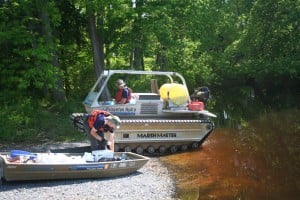

The U.S. Environmental Protection Agency has announced the final version of a $14 million plan to replace the soil on 33 residential properties in Voorhees and Gibbsboro that have been contaminated with lead and arsenic due to the former Sherwin-Williams paint manufacturing plant in Gibbsboro.
EPA officials said the plan involves excavating soil at the properties and disposing of it at facilities licensed to handle such environmentally harmful waste materials, after which the excavated areas would be refilled with clean soil, with vegetation replanted if necessary.
The soil contamination on the properties is a result of waterways and lands being affected by uncontrolled releases from the former Sherwin-Williams plant, which operated from the mid 1800s until closing in the late 1970s.
As the properties fall within the sphere of the designated Sherwin-Williams/Hilliards Creek Superfund site, Superfund laws dictate the plan will be funded entirely by Sherwin-Williams and conducted under EPA supervision.
The EPA originally proposed the plan to the public at a June meeting in Gibbsboro, during which EPA Remedial Project Manager Ray Klimcsak said Sherwin-Williams had “come to the table” during the process.
At that June meeting and through Aug. 1, Voorhees and Gibbsboro residents were able to ask questions of EPA officials, as well as comment on the plan and make suggestions.
Comments and concerns from the public were then addressed and released in the final version of the EPA’s plan.
The EPA now moves on to a phase known as “remedial design,” which is described on the EPA’s website as the phase during which the “technical specifications for cleanup remedies and technologies are designed.”
EPA officials did not have a date for when the actual cleanup process would begin, although at the June meeting, Klimcsak said he believed it was a “reasonable” estimate that shovels could be in the ground within a year-and-a-half to two years, with the process taking about three years to complete.
EPA officials said the agency would coordinate with property owners to ensure work is done with minimal disruption.
As detailed by EPA Regional Administrator Judith Enck, exposure to lead for children can result in reading and learning disabilities, reduced attention spans, I.Q. deficiencies, hyperactivity, impaired hearing and behavioral problems. Exposure to lead can also harm pregnant women, fetuses and members of the general population, as well as the environment as a whole.
“Lead is a potent toxic metal that can cause damage to a child’s ability to learn and a range of other health problems,” Enck said. “It is imperative that the toxic contamination at this site and at homes is addressed to protect people’s health.”
Within the EPA’s plan are also statements from EPA officials noting that evaluations have indicated there is a “very low” potential for flooding events to redeposit contaminated sediments on residential properties.
Those evaluations factored into to the final decision of conducting remediation of residential properties before addressing the upstream sources or the adjacent water bodies.
For those in Voorhees concerned about the health of Kirkwood Lake as a whole, repeated statements from EPA officials have marked sometime in 2018 as still the most likely time for when the EPA would decide on what remedy would be used to remediate the lake, with the actual cleanup to follow in the years after that.
To view the Sherwin-Williams/Hilliards Creek Superfund web site, visit www.epa.gov/region02/superfund/npl/sherwin/.
The EPA’s plan is available at semspub.epa.gov/src/document/02/372865.









